A summary of the civil airlines which operated British Government contracts for passenger and freight courier flights between
Great Britain and the then top secret Woomera Rocket Range in South Australia between 1955-1976.
Compiled by Geoff Goodall

Air Charter Ltd Avro Tudor 4B "Super Trader" G-AHNO named "Conqueror" at Adelaide Airport 1957 while operating the
British Ministry weekly courier service between London, Woomera and Adelaide. B. Shipway collection via Nigel Daw
British Ministry weekly courier service between London, Woomera and Adelaide. B. Shipway collection via Nigel Daw
In 1952 Britain detonated its first atomic bomb in the Monte Bello Islands group off Onslow WA. The following year two more British atomic bombs were detonated at the top of 200 feet towers at Emu Claypan in the SA desert. The Emu test site and village was abandoned when it was contaminated by the radioactive cloud of the second test. A new atomic testing site was established 100 miles to the south and given the name Maralinga where a series of atomic devices were detonated on the ground and dropped from RAF Valiants until 1960.
All this military weapons development was overseen by the Long Range Weapons Establishment. In January 1955 LRWE was restructured as Weapons Research Establishment based at Salisbury on the northern outskirts of Adelaide on a site where a new military airfield was being constructed. Named RAAF Edinburgh, its initial role was to support the RAAF and RAF activities activities at Woomera and Maralinga, including target drone Meteors and Canberras. A RAAF courier service between Woomera and Adelaide carried high clearance personnel and equipment using C-47s, Bristol Freighters, Percival Princes and in the early days a Vickers Viking. The Adelaide base for the Woomera courier flights was RAAF Mallala, moving during 1956 to the newly built RAAF Edinburgh. By the early 1950s a regular British military courier service was operated between Britain and Woomera and LRWE Adelaide by RAF Transport Command using Handley Page Hastings.


A Hastings arrives at Woomera circa 1955, with a RAF Westland Whirlwind helicopter above.
Civil Aviation Historical Society David Newell collection
Civil Aviation Historical Society David Newell collection

Division of Aircraft Production military aircraft maintenance hangars. Nigel Daw collection

Photo: South Australian Aviation Museum
For reasons not readily apparent, the civil airlines on the London-Woomera-Adelaide-London courier used Adelaide (West Beach) Airport rather than the much more logical RAAF Edinburgh 10 miles away where WRE HQ was located. Instead of having the operation hidden behind Edinburgh's high security, Adelaide aviation ethusiasts were treated to the weekly British courier visits at their civil airport. Each arrival and departure was overseen by officious Commonwealth Police officers in a high state of agitation briefed to protect the top secret cargo from prying public eyes, even if it was just the passengers' personal suitcases. Dire threats were bellowed at anyone with a camera. Rather than use the facilities of the Airport Terminal building, the Tudors parked outside the Australian National Airways hangar where passengers were processed in a small terminal room in the side of the hangar.

Robert Wiseman collection

G-ANTJ is seen later in 1959 at Adelaide Airport when assumed to be cross-hired by Air Charter Ltd.

windows are faired over for freight, passenger seating at the rear. Both photos by John Hillier

Photo by Geoff Goodall
After the Avro Tudor had been rejected by BOAC and retired by other operators, Laker purchased every available Tudor and with his heavy maintenance company Aviation Traders Ltd devised modifications to turn the unloved Tudor into an effective air transport. Among the Tudors acquired were four Mk.4s which ATL lengthened the forward fuselage by 6 feet (1.8 metres). Aviation Traders also rebuilt two other short fuselage models with the extended fuselage. During their rebuilds by ATL, the six stretched Tudors were fitted with uprated RR Merlin 623 engines, re-routed hydraulic and pneumatic lines, Avro Shackleton main undercarriage and a large 6ft 10 inch wide rear cargo door. All pressurisation equipment was removed. Laker named these six modified stretched Tudor Super Traders. The model received British type certification in March 1955 as Tudor Mk.4B with a significant increase in All Up Weight to allow an extra three tons of payload.
Freddie Laker's faith in his rebuilt Super Traders was soon rewarded when Air Charter Ltd gained British Ministry of Defence contracts to operate these aircraft to carry military personnel and freight to German and Far East military bases. In early 1955 Air Charter won the bidding for a new contact for a weekly return service from London-Stansted Airport to Woomera and on to Adelaide for LRWE personnel. The cabin was configured for cargo plus a block of rear-facing passenger seats. The Tudors were scheduled to take 14 days to complete each 24,000 miles (39,000km) return Australian service. The inaugural Woomera courier departed Stansted on 30 March 1955 flown by Tudor Super Trader G-AHNI. The Air Charter Ltd Super Trader fleet comprised:
G-AGRG El Alamein
G-AGRH Zephyr
G-AHNI Trade Wind
G-AHNL Mistral
G-AHNM Cirrus
G-AHNO Conqueror
The standard route to Australia was first leg Stansted-Brindisi, Italy then via Turkey, India, Singapore, Darwin to Woomera. The weekly schedule required the aircraft to arrive at Adelaide Airport late Saturday afternoon for a night-stop. Maintenance was carried out by the aircraft's Flight Engineer with assistance from Trans-Australia Airlines which was contracted for ground-handling the Adelaide turn-around. Adelaide freight would be loaded and the aircraft prepared for the long haul back to London. Sunday afternoon boarding of security-cleared passengers and their families took place though a small passenger terminal in the side of the ANA hangar. This temporary terminal was used for ANA and Guinea Airways services prior to the new Adelaide Airport terminal building being completed in August 1957. When the new terminal took over, the disused ANA (by now Ansett-ANA) hangar passenger room was retained for a period solely for the Woomera courier flights, probably to maintain the Governmental secrecy associated with all the British military activities in Australia.
In addition to the scheduled courier, Air Charter Tudors flew additional charters to Woomera carrying dismantled rockets and equipment. For operational reasons some Tudor flights to Woomera were routed via North America, Hawaii and Fiji. The Tudors also gained much work in connection with the British H Bomb tests at Christmas Island in the Pacific south of Hawaii.
Air Charter Ltd planned to replace its Tudors with Douglas DC-4s on the Woomera contract during 1959. But their retirement was hastened by two accidents enroute to Australia carrying classified cargo:
- 27 January 1959 G-AGRG crashed on takeoff Brindisi, Italy and destroyed by fire. During the takeoff roll the aircraft veered to the edge of the runway in a strong crosswind. The port undercarriage was torn off by rough terrain on the runway edge and fire broke out. Captain and First Officer died, the 4 other crew survived. No passengers.
- 23 April 1959: G-AGRH struck Mount Suphan near the Turkey-Armenia border at 13,000 feet elevation and was destroyed. The Tudor which had departed Ankara for Bahrein carrying top secret missile sections bound for Woomera, drifted north of the flight planned track which would clear the mountains. The wreckage was sighted 6 days later and a RAF team urgently despatched by helicopter from Cyprus. After confirming there were no survivors among the 12 occupants, the team collected documents and items from the wreckage before using explosives carried into the site to demolish the remaining cargo items. There was unproven suspicion that Soviets in Armenia had activated a decoy NDB radio navigation aid to guide the aircraft into high terrain. There was also speculation that the secret cargo included a nuclear device and rumour had it that local villagers who heard the crash and looted the wreckage and deceased before the RAF arrived, suffered from exposure to radiation and abnormally high cancer rates.

Air Charter Ltd Tudor 4B G-AGRG at Adelaide Airport in 1957. Photographer Fred Mole wrote on the back of
this print "A Tudor coming out overhead on a Sunday morning with four 1,810 hp Rolls Royce Merlins was
something never to be forgotten. How sweet and noisy." Civil Aviation Historical Society SA
this print "A Tudor coming out overhead on a Sunday morning with four 1,810 hp Rolls Royce Merlins was
something never to be forgotten. How sweet and noisy." Civil Aviation Historical Society SA

Air
Charter Ltd Tudor 4B Super Trader G-AHNO at Adelaide
1957.
B. Shipway collection via Nigel Daw



Here G-AHNL receives a hosing down at Perth Airport on Boxing Day 1958.
If I had been asked what was wrong with the Tudor I would have said very little, although having the wheels the other way round might have helped. When we were flying the USA the appearance of a Tudor of short finals would often elicit a call from the Tower "Check your nosewheel sir, it does not appear to have lowered".
At the end of April 1959 the Tudor Super Traders were withdrawn from the Woomera courier, replaced by DC-4s. The first DC-4 service departed Stansted on 16 April 1959 under the command of Captain Couch. The DC-4s then settled into the regular schedule to Adelaide, with occasional services operated by Air Charter Britannias. A typical DC-4 service that has been recorded was by G-AOXK again with Captain Couch: loaded with a massive consignment of 10,297 kg (11 tons) of Ministry of Supply stores, the DC-4 was airborne from Southend at 0819 Local bound for Adelaide via first stop Benina. The round trip on this occasion took 19 days, returning with a 3.5 ton load of MOS equipment and Jindivik target drones.
Air Charter's DC-4s were flown to Adelaide by Captains Andrew, Cobden, Emmert, Lane, Paton, Rawlins, Scorgie and Webber.
The following were seen at Adelaide Airport during 1960:
DC-4 G-ANYB Atlanta
DC-4 G-AOFW Jason
DC-4 G-AOXK Golden Fleece
DC-4 G-ANPH
Britannia 307 G-ANCD
Britannia 307 G-ANCE

Air Charter Ltd's first Bristol Britannia G-ANCE at Adelaide Airport on 8 February 1959.
Photo: Civil Aviation Historical Society SA via SA Aviation Museum
Photo: Civil Aviation Historical Society SA via SA Aviation Museum

overnight stops at Adelaide Airport in 1960. Both photos by Alan Fraser via Maurice Austin collection


Here's BUA Britannia G-ARWZ at Adelaide Airport in May 1962. Photo by Geoff Goodall
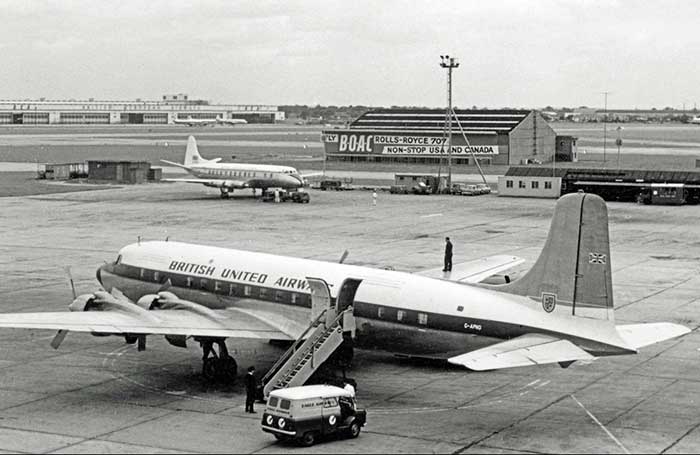
Photo by R.A.Scholefield
A typical loading was noted on 7 April 1962 when dismantled Jindiviks A92-248 and A92-249 were taken on board BUA DC-4 G-APNH which departed several hours later for Britain.


They were painted all white with RAF roundel and sequential RAAF A92- series serials. Photo by Geoff Goodall
Established in 1948 as Eagle Airways Ltd by 25 year old Harold Bamberg to operate Halifax freighters on the Berlin Airlift, Eagle became one of the leading British independent airlines with worldwide operations. In March 1960 the Cunard Steamship Company acquired a controlling financial interest and the name wa changed to Cunard Eagle Airways. After a tumultuous partnership Harold Bamberg regained financial control in February 1963 and in August that year changed the name to British Eagle Airways.
The inaugural Cunard Eagle Airways service to Woomera departed London-Heathrow on 8 June 1962 flown by DC-6A G-ARZO. Their gleaming red DC-6s quickly became regular visitors at Adelaide Airport. The first service by the promised Britannias came on 7 October 1963 when G-ARKA Good Fortune arrived from London and Woomera. It and sister G-ARKB Endeavour replaced the DC-6s by early 1964, giving much reduced flight times but lacking cargo doors. This was solved in typical Bamberg fashion by purchasing two early model Britannias from an Argentina airline and having large freight doors cut into the forward port fuselage. This pair G-ANCF New Frontier and G-ANCG Trojan operated the majority of British Eagle Airways' renewed contracts on the Adelaide courier.
G-ANCG was lost 20 April 1967 soon after departing Heathrow on an Adelaide service with 11 Crew and 54 passengers. The undercarriage retraction system failed leaving the left bogie extended at an incorrect aligment. Captain Don Chubb was diverted to RAF Manston for an emergency landing on a foamed runway. There were no injuries but the aircraft was written off.
British Eagle continued the Adelaide contract with Britannias. Later in the 1960s reduced Woomera activity meant it was rarely a stop. A typical Britannia flight schedule dated 16 February 1968 shows:
| Heathrow to Istanbul | 5hr 30min |
| Istanbul-Bombay | 7 hr 30 min |
| Bombay-Singapore | 9 hr 30 min |
| Overnight hotel stay Singapore | |
| Singapore-Darwin | 6 hr 30 min |
| Darwin-Adelaide | 5 hr 00 min |
During 1968 a series of commercial and financial problems resulted in the British Eagle, which had 2,300 employees at the time, being forced to cease operations on 6 November 1968. Their last service on the Australian courier was flown by Britannia G-ANCF which departed Heathrow on 31 October 1968 and reached Adelaide on 2 November. It arrived back at Heathrow on 5 November, the day before the airline shut down.
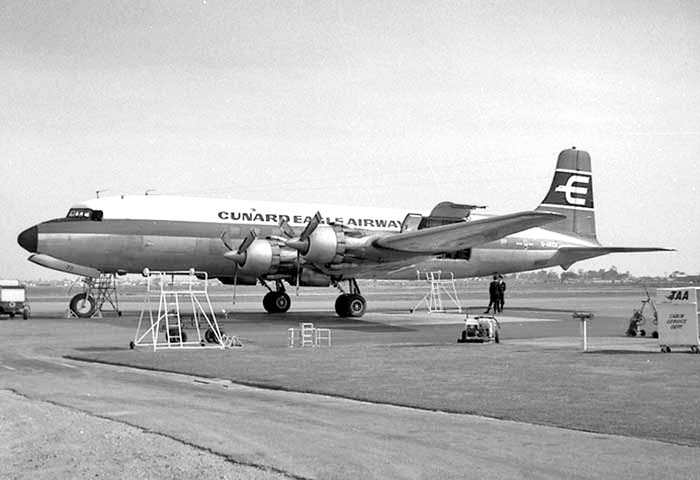
Photo by Geoff Goodall
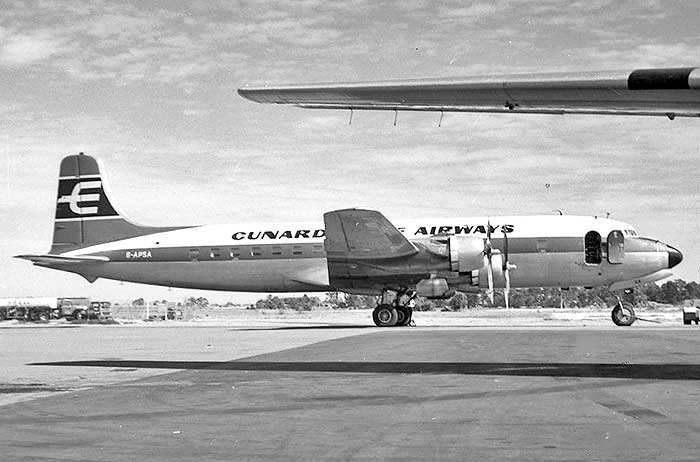

Both at Adelaide, G-ARMY above July 1963, G-APSA below in December 1963.


G-ARKB at Adelaide in February 1963. Note the lack of cargo doors. Photo by Geoff Goodall
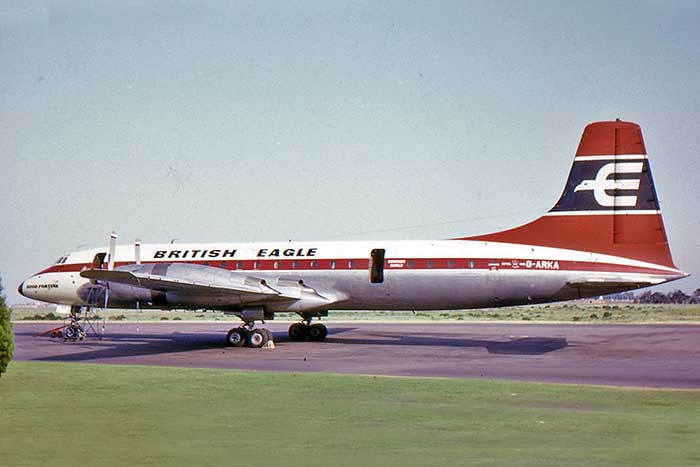
above G-ARKA "Good Fortune" in October 1963, below G-ARKB "Equality" in July 1966.

"I did the London-Australia trips five times between November 1963 and March 1973. Among them was the April 1967 British Eagle Britannia wheels-up landing at Manston in G-ANCG. We were carrying 30 wives and babies of Army men working at Maralinga at the time, engineers and freight. After takeoff from Heathrow, one undercarriage leg didn’t retract with a hydraulic leak the cause. The crew decided to dump most of the 13 hours of fuel over Southern England then make an emergency landing at Manston.
I was detailed by the cabin crew to sit in an escape aisle and jump out first when the door was blown off, slide down the inflated chute and catch the fragile jumpers as they emerged. However the pilot did a perfect landing with undercarriage unlocked on to a carpet of foam previously put down by a lot of local fire brigades from Kent. So the belly slid a long way and my door was only a few inches from earth and consequently the escape chute didn't extend. As people started stepping out on to the ground a loudspeaker said ‘run like hell’ and we all dashed to some Nissen huts. What we found there where, believe it or not, was HM Customs people who impounded our Duty Free purchases from London Airport. They said "You'll get them back before flying again tomorrow.
The news was all over the TV and next day’s papers so I had to urgently phone my parents from the hotel. One enterprising bloke spoke to the media and earned a good night on the town. The next morning we took off in another British Eagle Britannia, drinks on the house all the way, but we only found that out after the flight! British Eagle owner Mr.Bamberg was standing at the bottom of the steps as we boarded to make sure things went well. G-ANCG lay on its belly beside the main road Canterbury to London for ages, Mr. Bamberg having quickly had the airline name painted over.
There were pleasant stopovers in Bombay, Colombo and Singapore in pretty good hotels. The 24 hour stopovers allowed us to buy Duty Free goods for our return."
An Air Ferry Ltd Douglas DC-6A, either G-APNO or G-APNP made a return charter to Adelaide, logging 88 hours 40 minutes flying by the time it returned to home base Manston. There was no sighting at Adelaide Airport so it is assumed to have used RAAF Edinburgh.
In August 1966 the Scottish airline ACE Freighters was chartered by the MoD for a return flight to Adelaide carrying classified Weapons Research Establishment cargo in both directions. ACE Freighters operated a fleet of Lockheed L.749A Constellations, allocating G-ALAK to the long haul to Australia. It was positioned to RAF Lyneham in southern England for loading. G-ALAK departed Lyneham just before 1am local time 24 August 1966 under the command of company chief pilot Captain J.W.Villa. First refuelling stop was Athens, then stops at Teheran, Masirah, Gan, Cocos Islands, Perth before reaching RAAF Edinburgh on 29 August. The next morning the Constellation departed Edinburgh on the return journey, arriving back at RAF Lyneham from Brindisi on 4 September at 7am local time.
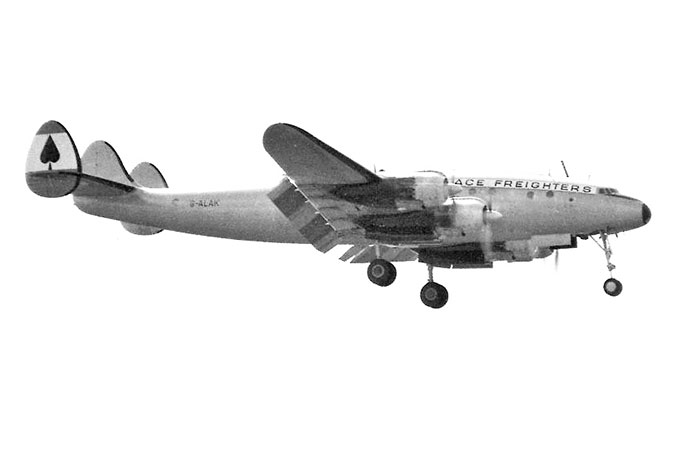
Monarch Airlines sent Britannia G-ANCH on a proving flight along the Australia route, arriving at Adelaide Airport 21 November 1968. The inaugural fortnightly Monarch scheduled courier service departed Luton on 18 December 1968 in Britannia G-ANCF, refuelling stops at Kuwait, Bombay, Singapore and Darwin. G-ANCF with large cargo door had just been purchased from British Eagle's liquidators and was to fly the majority of Australian courier runs over the next seven years. The bright yellow Monarch Britannias became a regular sight at Adelaide, usually G-ANCE, G-ANCF, G-AOVH or G-AOVT. For political and operational reasons (adverse upper winds), the Monarch Britannias routinely routed clear of Indonesian airspace by crossing the Indian Ocean to the south via RAF Gan in the Maldives, Cocos Islands and Perth.
During February-March 1973, G-ANCE and G-ANCF were chartered by Trans-Australia Airlines to join an relief airlift of food and supplies to Alice Springs NT which was isolated by inland floods.
British defence research and testing activities at Woomera, Maralinga and WRE Salisbury were wound down during the early 1970s and the frequency of the courier service reduced. Consequently, during 1975 the British Defence Ministry determined the need for the high security Australian courier no longer existed. The final service departed Adelaide Airport on 15 December 1975 when Monarch Airlines Britannia G-ANCF climbed out bound for London.
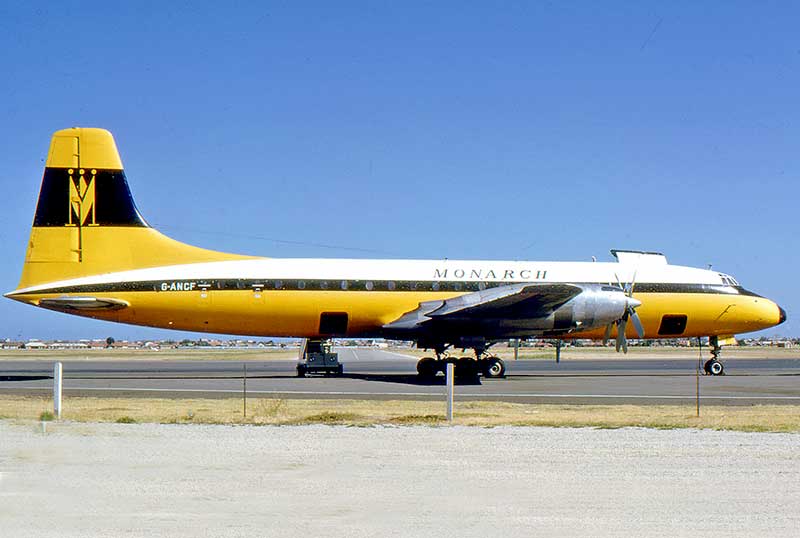

- British Independent Airlines since 1946, Tony Merton-Jones, January 1976
- South Australian Air Journal, West Beach Aviation Group, monthly newsletter from June 1963
- Ill Wind, Roger Carvell, The Aviation Historian issue No.2 , January 2013 - the mountain crash of Tudor G-AGRH
- Constellation Swansong - ACE Freighters, Peter J. Marson, Propliner Annual 2020
- Tanganyika's Big Doug, DC-4 G-AOXK, Paul Howard, Propliner magazine No.54 Spring 1993
Back to the Australian Aviation Menu